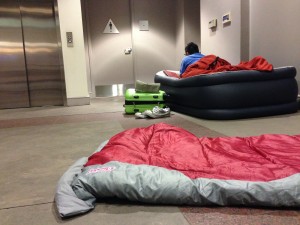Takeaways from MuseumCamp
Posted: August 12, 2014 Filed under: Ken® | Tags: voicekwon 1 Comment »I recently went to camp at the Santa Cruz Museum of Art & History (MAH) and spent several days and nights with museum professionals, arts consultants, community organizers and the like, convinced that this year’s theme of social impact assessment would have something to do with the themes I explore on this toilet blog. After breaking up into teams, each team identified a social outcome to measure at a local site in Santa Cruz. Teams tested hypotheses ranging from watching films at the Del Mar Cinema increasing civic pride for locals to people with a shared affinity in a specific artist being more likely to interact with strangers at the Kuumbwa Jazz Center. You can read about the projects here — my team project is the one with the typo that says “pubic art” instead of “public art.”
I found that many of the questions that the teams raised to formulate the hypotheses were of the sort that I think about when I review sites for JAZZ TOILET: Who is coming to these places? How is the organization serving its community? How is the community defined and who is excluded? Is this venue positively or negatively impacting the arts economy? How does the location and layout attract/repel certain populations? What relationship does the listener have to the music, to the venue?
 My head is full of questions, some seemingly too fluffy to be answered with hard data. MuseumCamp has taught me though that we can answer those questions by formulating hypotheses in response, identifying indicators, developing and using creative evaluation tools to measure the indicators, and analyzing the results.
My head is full of questions, some seemingly too fluffy to be answered with hard data. MuseumCamp has taught me though that we can answer those questions by formulating hypotheses in response, identifying indicators, developing and using creative evaluation tools to measure the indicators, and analyzing the results.
Moreover, conversations and moments at the Santa Cruz MAH have resparked my career as an artist, which has been largely dormant in my early retirement as a resigned twenty-something this past year. Place and posture can exert great influence on creativity and I discovered the museum to be an inspiring home. Feeling tired, I sat down on one of the two painted chairs in its three-floor elevator; the act of sitting in a museum elevator spurred me to think that my Brazilian Jazz duo should perform in elevators.
A term often applied to bossa nova in a derogatory fashion, it would be interesting to turn “elevator music” on its head and provide world-class bossa nova to anyone that enters the elevator. Live elevator music would be the antithesis of elevator music. If you see a person with a MuseumCamp patch on her backpack scoping out elevators in Manhattan, that’ll be me. Please feel free contact me if you have suggestions for elevators or are interested in having me in your elevator. And as they say on Craigslist, serious inquiries only.
Other than learning that the immeasurable is measurable and feeling rejuvenated creatively, I came back from camp thinking that when I grow old, I would like to be one of those people that pronounces the words humor and human with a Y instead of an H sound, just like my team mentor Paul Harder. My sister advised against it, however, and said that I would have to also pronounce the word schedule without the hard C sound so now I’m on the fence about it.
Finally, my only regrets from MuseumCamp are the following: not walking to the beach to see the seals; forgetting the proper pronunciation of the word lanyards; and not getting to meet all ninety-nine of the other happy campers. Thanks to Fractured Atlas for sending me to camp, Nina Simon and Ian Moss for being the best camp counselors and fellow campers for sharing much of themselves. Camp buddies for life!

[…] http://www.jazztoilet.com/museum-camp/ […]